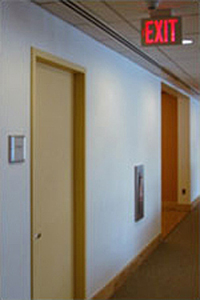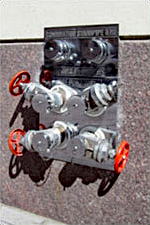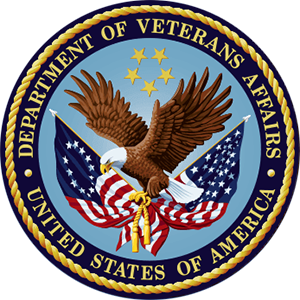Overview
Within This Page
The United States has the highest fire losses in terms of both frequency and total losses of any modern technological society. New facilities and renovation projects need to be designed to incorporate efficient, cost-effective passive and automatic fire protection systems. These systems are effective in detecting, containing, and controlling and/or extinguishing a fire event in the early stages. Fire protection engineers must be involved in all aspects of the design in order to ensure a reasonable degree of protection of human life from fire and the products of combustion as well as to reduce the potential loss from fire (i.e., real and personal property, information, organizational operations). Planning for fire protection in/around a building involves knowing the four sources of fire: natural, manmade, wildfire and incidental and taking an integrated systems approach that enables the designer to analyze all of the building's components as a total building fire safety system package. The analysis requires more than code compliance or meeting the minimum legal responsibilities for protecting a building; that is, building and fire codes are intended to protect against loss of life and limit fire impact on the community and do not necessarily protect the mission or assets, or solve problems brought upon by new projects with unique circumstances. Therefore, it is necessary to creatively and efficiently integrate code requirements with other fire safety measures as well as other design strategies to achieve a balanced design that will provide the desired levels of safety (evacuation, recovery, egress/smoke. Identify critical systems: diesel generators, etc.).
Performance-Based Design (PBD)
The success of any complex project hinges on getting all the stakeholders, owners, designers, special consultants, and AHJs working together in a collaborative manner to achieve performance-based design solutions. The Society of Fire Protection Engineers (SFPE) has developed and published (in collaboration with NFPA) the SFPE Engineering Guide to Performance-Based Fire Protection Analysis and Design of Buildings and the SFPE Code Official's Guide to Performance-Based Design Review (developed and published in collaboration with ICC).
Recommendations
Issues to address in developing a successful fire protection design usually include:
Design Team—It is most important that the project delivery team include a Fire Protection Engineer with adequate experience and knowledge in fire protection and life safety design. The Fire Protection Engineer should be involved in all phases of design, from planning to occupancy. GSA and DoD require a licensed professional engineer on their projects.
Design Standards and Criteria (i.e., Building Code, etc.)—to be utilized by the design team, including statutory requirements, voluntary requirements addressing owner's performance needs, and requirements that are sometimes imposed by insurance carriers on commercial projects.
Site Requirements—A quality site design will integrate performance requirements associated with fire department access, suppression, and separation distances and site/building security.
- Fire department access
- Design buildings with uncomplicated layouts that enable firefighters to locate an area quickly.
- Provide rapid access to various features such as fire department connections (FDCs), fire command center, fire alarm control equipment, fire pump room, hose valves, elevators and stairs, annunciators, key boxes, etc.
- Accommodate the access of fire apparatus into and around the building site
- Comply with local authorities having jurisdiction to accommodate the access of fire apparatus into and around the building site and to coordinate access control point layout.
- Fire hydrants
- Coordinate with security measures
Building Construction Requirements, at a minimum will address the following elements:

- Construction type, allowable height, and area
- Exposures/separation requirements
- Fire ratings, materials, and systems
- Occupancy types
- Interior finish
- Exit enclosure
Life Safety, at a minimum will address the following elements:
- Exit access paths
- Exit remoteness
- Exit discharge
- Areas of refuge
- Accessible exits
- Door locking arrangements (security interface)
- Occupancy
Fire Detection and Notification System Requirements, at a minimum will address the following elements:
- Detection
- Mass Notification
- Survivability of systems
- Alarm Notification and Fire
Fire Suppression Requirements, at a minimum will address the following elements:

- Water supply
- Type of automatic fire extinguishing system
- Water-based fire extinguishing system
- Non-water-based fire extinguishing system
- Standpipes and fire department hose outlets
- Non-water agents
Emergency Power, Lighting, and Exit Signage, at a minimum will address the following elements:
- Survivability of systems
- Electrical Safety
- Distributed Energy Resources
Special Fire Protection Requirements, at a minimum will address the following elements:
- Engineered smoke control systems
- Special hazard systems
- Fireproofing and firestopping
- Atrium spaces
- Mission critical facility needs
Related Issues
Balancing Safe and Secure Design Requirements
The concern for terrorist attacks has caused design and engineering professionals to address integrated fire protection and security measures for the building site as well as within the building. For example, perimeter protection measures must be well-designed to ensure that fire departments can still access sites and buildings. Another example is the increased need to coordinate HVAC design and proper automatic emergency operations in the event of a fire or chemical/biological/radiological (CBR) event.
With the proliferation of vegetative roofs on buildings to reduce heat island effect and control storm water runoff, consideration must be given to firefighters having to ventilate a structure during a major fire event. Provide adequate roof hatches and other access points for firefighters.
Virtually every project that requires fire protection must also meet sustainability goals. Thus, it is important to balance security/safety goals with those for sustainability for example, specify fire resistant materials that are durable and can meet green products standards whenever possible. Further, consider life-cycle cost when making decisions on materials, equipment and systems.
Bollard spacing for accessibility related to access for fire vehicles and personnel. The Americans with Disabilities (ADA) Act calls for bollards to have 36 inch clear space between them to meet clear opening requirements. Site security designers need to balance security with access, considering bollard location and spacing respective to vehicular traffic, bus stops, hardened street furniture, and pedestrian traffic. Innovative arrangements of passive bollards and use of active barriers permit access while providing security.
Mass Notification
Notifying building occupants and visitors both inside and outside facilities of hazardous events has become a critical aspect of personnel safety and health. Whether it is a fire, chemical spill, criminal activity, or act of terrorism, everyone in the vicinity of such events must be warned so they know whether to shelter in place or flee—including which direction to go. Mass notification systems can be employed in single buildings or on campuses and military bases. Notices can be sent over loudspeakers, to computer monitors and to cell phones. See UFC 4-021-01 Design and O&M: Mass Notification Systems
Permeable Pavement
Permeable pavement is being specified more frequently as a means of controlling storm water runoff from building sites. Not all types of permeable pavement are designed to hold emergency fire and rescue vehicles. Coordinate with site designer/landscape architect to ensure permeable pavement selected will meet load requirements of emergency vehicles. Another option to consider is to use permeable pavement in parking lots for passenger vehicles and standard pavement for access roads, loading docks and driveways to building entrances.
Low Frequency Sounders for Sleeping Rooms
NFPA 72 low frequency sounder requirements went into effect on January 1, 2014 for sleeping areas in new buildings. These facility types are required to comply with the new code: hotel/motel guest rooms, college/university dormitory rooms, and assisted living facilities. NFPA 72 prescribes low frequency as a 520 Hz square wave tone.
Relevant Codes and Standards
Building codes and fire codes vary across the nation. For federal projects, consult with the appropriate federal agency or the Contracting Officer. For non-federal projects consult with the appropriate building code and fire code official, for minimum and recommended fire safety measures.
Legislation
- P.L. 93-498—Federal Fire Prevention and Control Act, 1974
- P.L. 100-678, Section 21—Public Building Amendments, 1988
- P.L. 102-522—Fire Administration Authorization Act of 1992 (aka Federal Fire Safety Act)
Federal Standards & Guidelines
- DOD UFC 3-600-01 Design: Fire Protection Engineering for Facilities
- DOE Office of Independent Enterprise Assessments, Emergency Planning and Response Resources
- GSA
- PBS-P100 Facilities Standards for the Public Buildings Service
- Fire Safety Retrofitting in Historic Buildings by Advisory Council on Historic Preservation and General Services Administration. 1989.
- HUD/NIBS Guideline on Fire Ratings of Archaic Materials and Assemblies
- Smithsonian Institution Fire Protection & Life Safety Design Manual
- VA
Codes and Standards
- ICC IBC International Building Code
- NFPA 101: Life Safety Code®
- NFPA 72: National Fire Alarm and Signaling Code
Other Publications
- Bridging the Gap: Fire Safety and Green Buildings , National Association of State Fire Marshalls
- Fire Publications: Evacuation—a compendium of research and position papers on all-hazard evacuation theory, NIST
- NFPA 1600: Standard on Disaster/Emergency Management and Business Continuity/Continuity of Operations Programs
- Commercial Roof-Mounted Photovoltaic System Installation Best Practices Review and All Hazard Assessment, The Fire Protection Research Foundation
Additional Resources
Standards and Code Organizations
- American National Standards Institute (ANSI)
- ASTM International
- FM Global
- International Code Council, Inc. (ICC)
- National Fire Protection Association (NFPA)
- Underwriters Laboratories Inc. (UL)
Associations
- American Fire Sprinkler Association (AFSA)
- Automatic Fire Alarm Association (AFAA)
- National Association of State Fire Marshals (NASFM)
- National Fire Sprinkler Association (NFSA)
- Society of Fire Protection Engineers (SFPE)
Laboratories
Universities
- Oklahoma State University School of Fire Protection and Safety Engineering Technology
- University of Maryland Fire Protection Engineering
- Worcester Polytechnic Institute Fire Protection Engineering
Others
Tools
- GSA Sustainable Facilities Tool (SFTool)—SFTool's immersive virtual environment addresses all your sustainability planning, designing and procurement needs.










